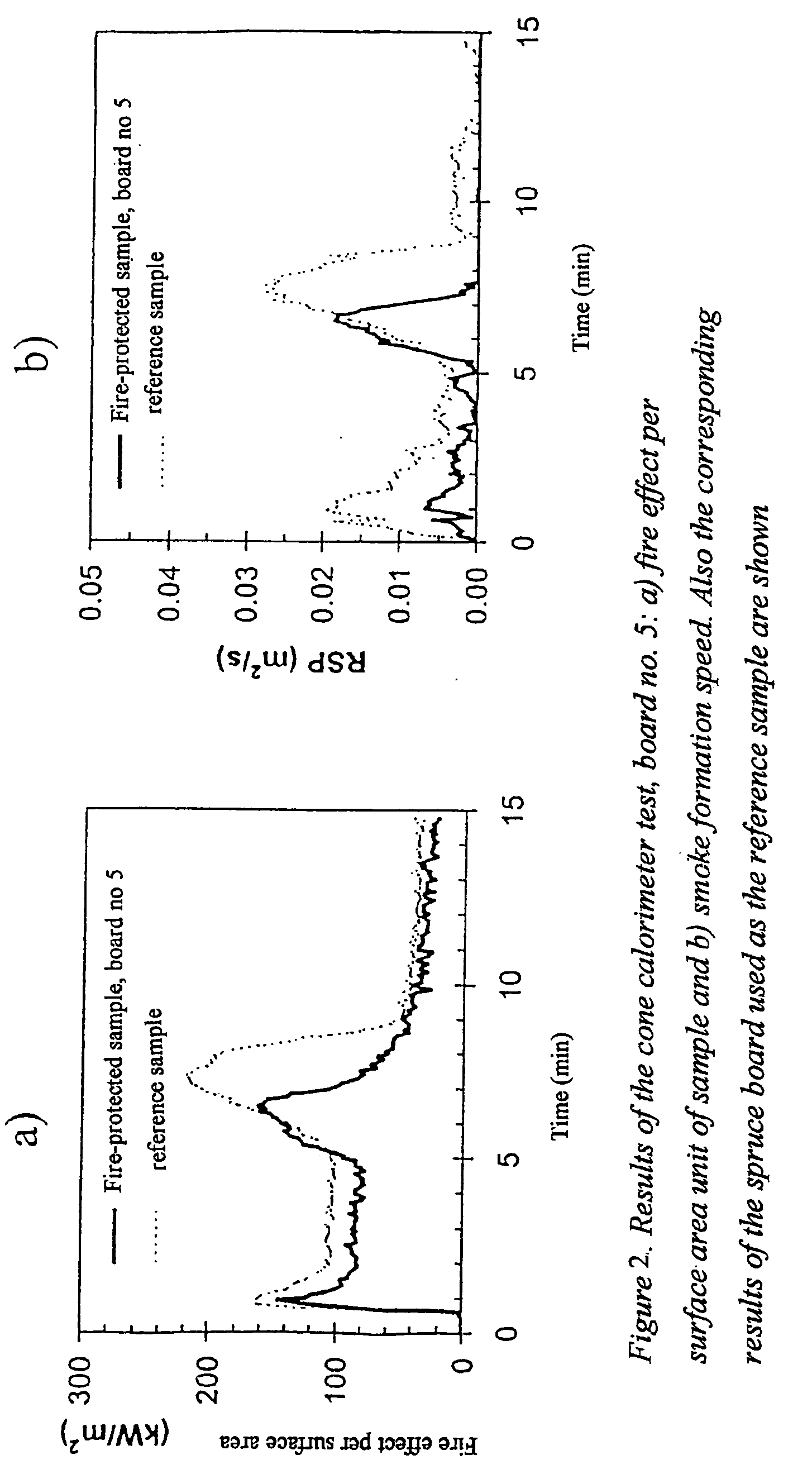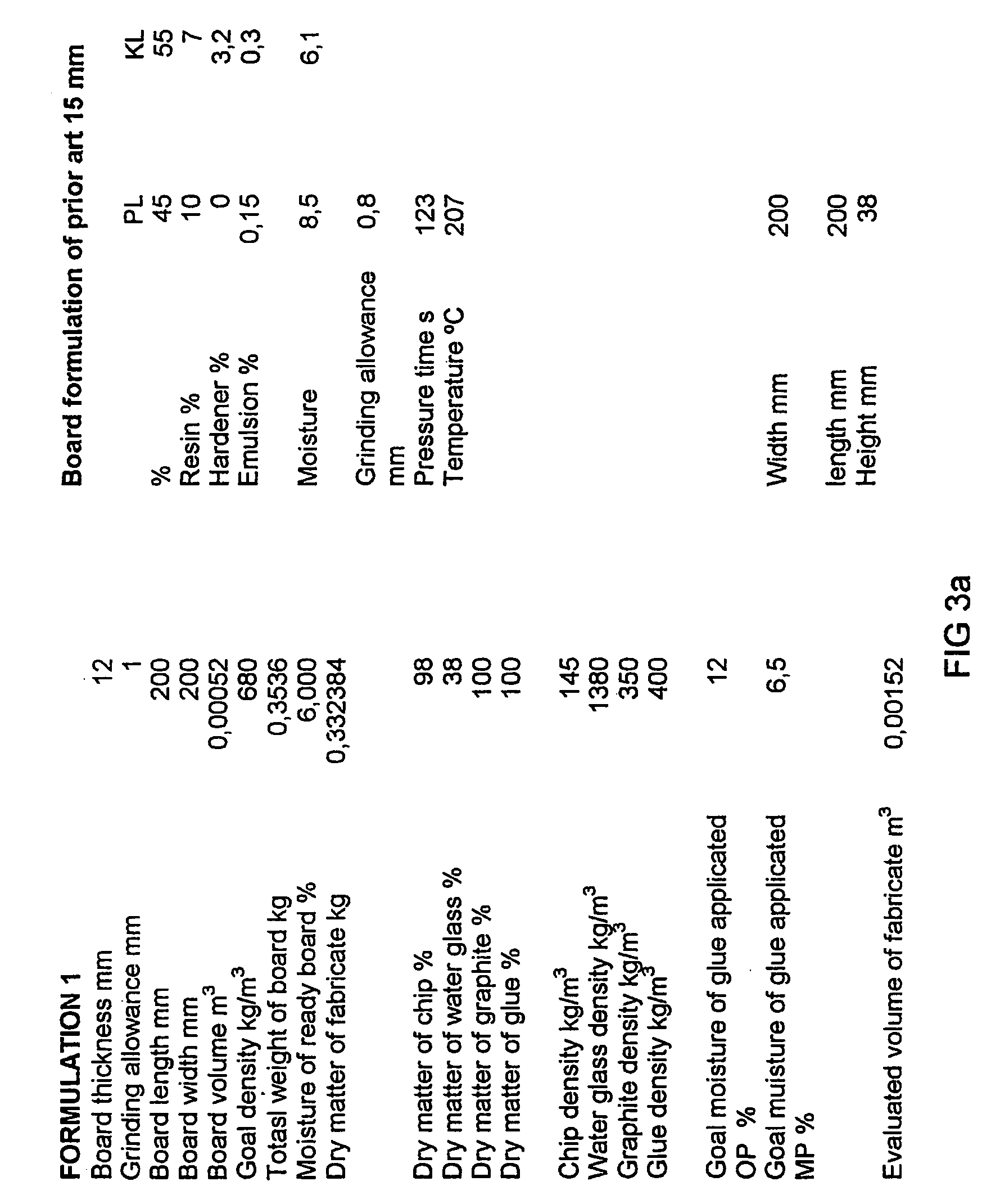Board product and method for the preparation of the same
a technology of board products and products, applied in the field of board products, can solve the problems of different harmful gases, such as formaldehyde, spreading from them to the indoor air of the building, and affecting the environment, and achieves the effects of not being particularly good at water resistance, reducing the risk of contamination, and reducing the use effect of materials
- Summary
- Abstract
- Description
- Claims
- Application Information
AI Technical Summary
Benefits of technology
Problems solved by technology
Method used
Image
Examples
example 1
[0017] Particle boards were prepared at VTT (Technical Research Centre of Finland) of surface and middle-layer particles delivered by Koskinen Oy for use in the preparation of particle boards. The glue material used was according to the following formulation, a mixture of water glass (Huber Engineered Materials, sodium silicate Zeopol 33), graphite powder.(delivered by the inventor) and wallpaper glue (bought from a store):
[0018] 30 dl chips=76 vol.-%
[0019] 6 dl sodium silicate=15,2 vol.-%
[0020] 2 dl graphite=5 vol.-%
[0021] 1,5 dl wallpaper glue=3,8 vol.-%
[0022] The density and dry material content of the materials to be used in the formulation were determinated so that the substances of the glued particle mass could be calculated as absolute masses before comprimation. These are presented in table 1.
TABLE 1Densities of used materialsDensityDrymaterialMaterialkg / cm3% of weightOuter-layer particle15698Middle-layer particle13797Sodium silicate138038Graphite350100Wallpaper glue1...
example 2
[0026] In this example, the wallpaper glue was left out from the formulation and two different water glass / graphite amounts were tested in relation to the particles. With the change in the formulation, there was strived both to a decreased total amount of particles in the board and to a decreased water content to be closer to a normal level (12-13%), because it is difficult to control the compression of a board in a higher water content. It was also strived to achieve a typical board density, 680 kg / m3.
TABLE 3Compositions of the formulations 1 and 2ParticlesWater glassGraphitevol. -%vol. -%vol. -%Formulation 1751510Formulation 28596
[0027] There were 42% of outer-layer particles and 58% of middle-layer particles in the particles to be glued. The whole formulations have been presented in FIGS. 3 and 4. In FIGS. 3 and 4 there have also been presented examples of board formulations of prior art.
[0028] The boards were pressed to a goal thickness of 12 mm and the calculational density ...
preparation example 2
[0037] Particle boards were prepared according to the following formulation:
[0038] 30 dl particles=82.2 vol.-%
[0039] 4 dl sodium silicate=11 vol.-%
[0040] 1 dl graphite=2.7 vol.-%
[0041] 1.5 dl wallpaper glue=4.1 vol.-%
[0042] The mixture was thoroughly mixed for ca ten minutes until a composition with a solid and uniform mass was obtained and from which a cohesive board could be prepared.
[0043] The mass was then placed in a form for preparation of a board. Baking paper was placed at the upper and lower surfaces of the board to avoid adhesion and the mass was compressed by pressing. The form was thereafter placed in an electric oven for 15 minutes in a temperature of 200° C. Thereafter, it was taken out from the oven and dried to a final dryness. The board hardened and the result was a cohesive board.
PUM
| Property | Measurement | Unit |
|---|---|---|
| humidity | aaaaa | aaaaa |
| compression pressure | aaaaa | aaaaa |
| height | aaaaa | aaaaa |
Abstract
Description
Claims
Application Information
 Login to View More
Login to View More - R&D
- Intellectual Property
- Life Sciences
- Materials
- Tech Scout
- Unparalleled Data Quality
- Higher Quality Content
- 60% Fewer Hallucinations
Browse by: Latest US Patents, China's latest patents, Technical Efficacy Thesaurus, Application Domain, Technology Topic, Popular Technical Reports.
© 2025 PatSnap. All rights reserved.Legal|Privacy policy|Modern Slavery Act Transparency Statement|Sitemap|About US| Contact US: help@patsnap.com



